Introduction
Attaining the Google Cloud Platform (GCP) Architecture Certification signifies a professional's adeptness in crafting and managing cloud solutions within the GCP ecosystem. As businesses navigate the complexities of digital transformation, the certification stands as a hallmark of proficiency, certifying that individuals are equipped to address and streamline multifaceted cloud challenges. These case studies exemplify the critical role that certified cloud architects play in innovating and refining technology-driven business solutions.
A Center of Excellence (CoE) further underlines this by emphasizing the 'people' pillar, alongside technology and processes, as the core framework for implementing effective cloud strategies. Statistics highlight the tangible benefits of certification, including the validation of skills and the bolstering of professional stature, which is increasingly recognized by employers. In the realm of data science and cloud computing, certifications not only confirm an individual's expertise but also complement hands-on experience, providing a competitive edge in the job market.
For professionals seeking to master the GCP Architecture Certification, this guide is a comprehensive resource, offering insights into essential architectural components, data engineering projects, and the strategic utilization of Google's cloud resources, including the initial $300 credit for new accounts. The aim is to equip individuals with the knowledge and skills to drive effective cloud management and innovation within their organizations.
Understanding GCP Architecture Certification
Achieving the Google Cloud Platform (GCP) Architecture Certification indicates a professional's proficiency in designing and overseeing solutions within the GCP ecosystem. As businesses navigate the complexities of digital transformation, the certification stands as a hallmark of proficiency, certifying that individuals are equipped to address and streamline multifaceted challenges in the digital world. For example, Visual Research utilized cloud-based technologies to revolutionize Japan's real estate sector, which previously grappled with inefficiencies stemming from paper-based processes and the absence of standardization. Likewise, Sanitas, a well-known Swiss healthcare insurer, moved its customer-facing infrastructure to the sky to enable developers and improve customer service.
These case studies exemplify the critical role that certified architects play in innovating and refining technology-driven business solutions. A Center of Excellence (CoE) further highlights this by emphasizing the 'people' pillar, alongside technology and processes, as the core framework for implementing effective strategies. The Center of Excellence (CCoE) specifically focuses on governance, addressing security, compliance, and cost management, thereby ensuring alignment with business objectives and fostering a culture of innovation.
Statistics highlight the tangible benefits of certification, including the validation of skills and the bolstering of professional stature, which is increasingly recognized by employers. In the field of data science and computing, certifications not only validate an individual's expertise but also enhance practical experience, giving a competitive advantage in the job market. A practical scenario where such expertise is paramount involves designing a resilient data lake architecture on the GCP, capable of adapting to changing data structures while preserving data integrity for reprocessing.
For professionals aiming to master the GCP Architecture Certification, this guide is a comprehensive resource, offering insights into essential architectural components, data engineering projects, and the strategic utilization of Google's cloud resources, including the initial $300 credit for new accounts. The objective is to provide individuals with the knowledge and skills to facilitate effective management and innovation within their organizations.
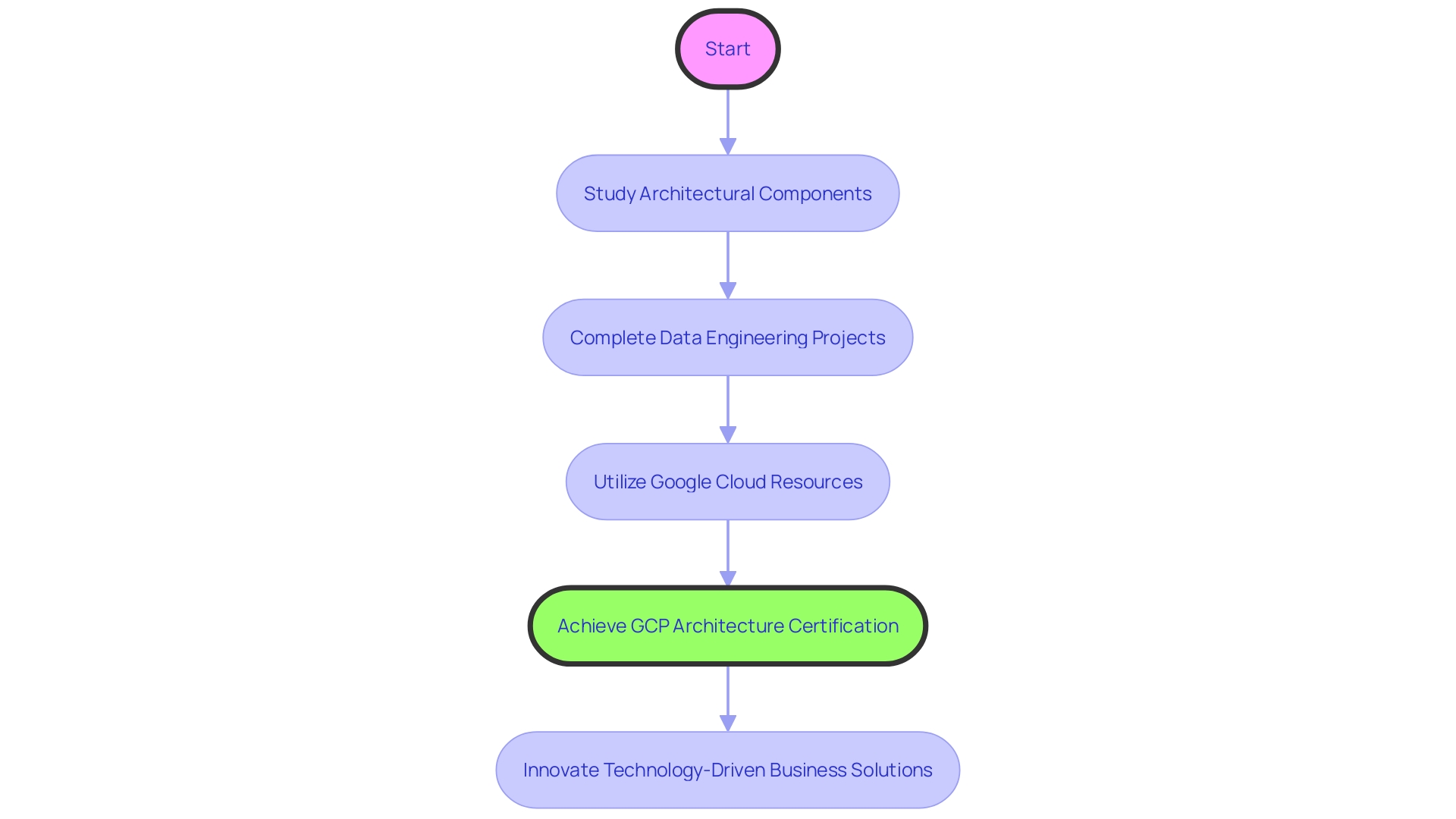
Exam Overview and Format
Grasping the structure of the GCP Architecture Certification exam is vital for any IT professional aiming to showcase proficiency in cloud design. The exam comprises multiple-choice questions that span various domains of Google Cloud Platform (GCP) structure. It's designed to evaluate a candidate's skills and knowledge in designing, managing, and implementing GCP solutions that are secure, scalable, and highly available.
Candidates are given a two-hour time frame to complete the exam, and a minimum passing score is required to obtain the certification. The exam's format is aligned with real-world scenarios, such as designing a low-latency, highly secure e-commerce portal or constructing a data lake with adaptable ingestion pipelines for a recommendation engine. These instances demonstrate the intricacy and fluidity of virtual environments, where the design must accommodate diverse data structures and guarantee uninterrupted business operations.
As cloud design becomes increasingly crucial for businesses—providing agility, scalability, and cost-efficiency—cloud architects are tasked with integrating components in a way that optimizes resource sharing and scaling. This certification validates the expertise required to navigate complexities, align system structure with business strategies, and maintain strong systems in the cloud. It's a testimony to a professional's ability to design structures adhering to best practices, such as Zero Trust principles, and keep pace with the evolving landscape of IT operations, including networking, identity, and governance.
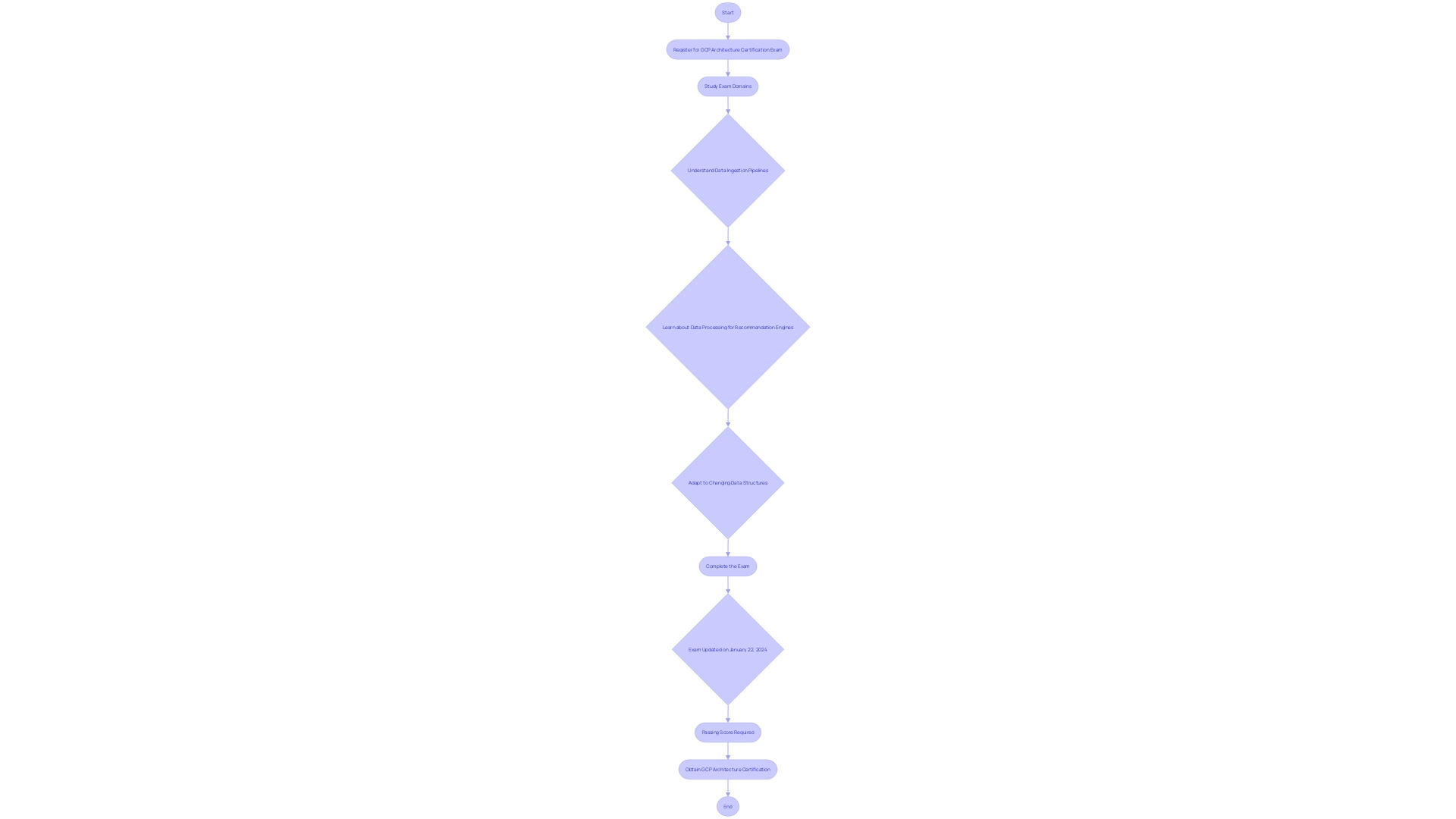
Key Skills and Knowledge Areas
Attaining the GCP Design Certification showcases a thorough expertise of cloud structure on Google Cloud Platform (GCP). To excel, candidates must grasp a multitude of competencies, ranging from designing robust cloud infrastructures to implementing secure and compliant data solutions. Expertise in network design is crucial, guaranteeing smooth connectivity and optimal performance across services. Equally important is the ability to craft resilient storage solutions that cater to varying business needs.
Security and compliance are paramount, requiring an in-depth understanding of protective measures and regulatory standards. The certification also demands proficiency in data processing and analytics, reflecting the growing importance of data-driven decision-making in modern business environments. The development and deployment of scalable applications are central to the certification, highlighting the need for agile and efficient release management.
The Developer Experts (GDEs), a community of enthusiastic technology professionals, often share practical experiences with GCP that can be valuable for certification aspirants. Their practical understanding of evolving big data structures, such as combinations of BigQuery, Firebase, and Looker Studio, and navigating the challenges that come with these technologies, can offer practical knowledge beyond the theoretical scope.
Furthermore, Certifications from the well-known search engine company are highly sought after in the IT industry, marking individuals as competitive and knowledgeable assets to potential employers. For instance, designing data lakes and developing auditable deployment systems are the kinds of advanced tasks that certified professionals are expected to manage, proving the practical value of these credentials.
As the realm of architecture—whether physical buildings or digital infrastructures—continues to evolve, incorporating sustainable and innovative solutions becomes crucial. The GCP Architecture Certification is a testament to an individual's commitment to continuous learning and their ability to contribute significantly to both their organization and the wider community.
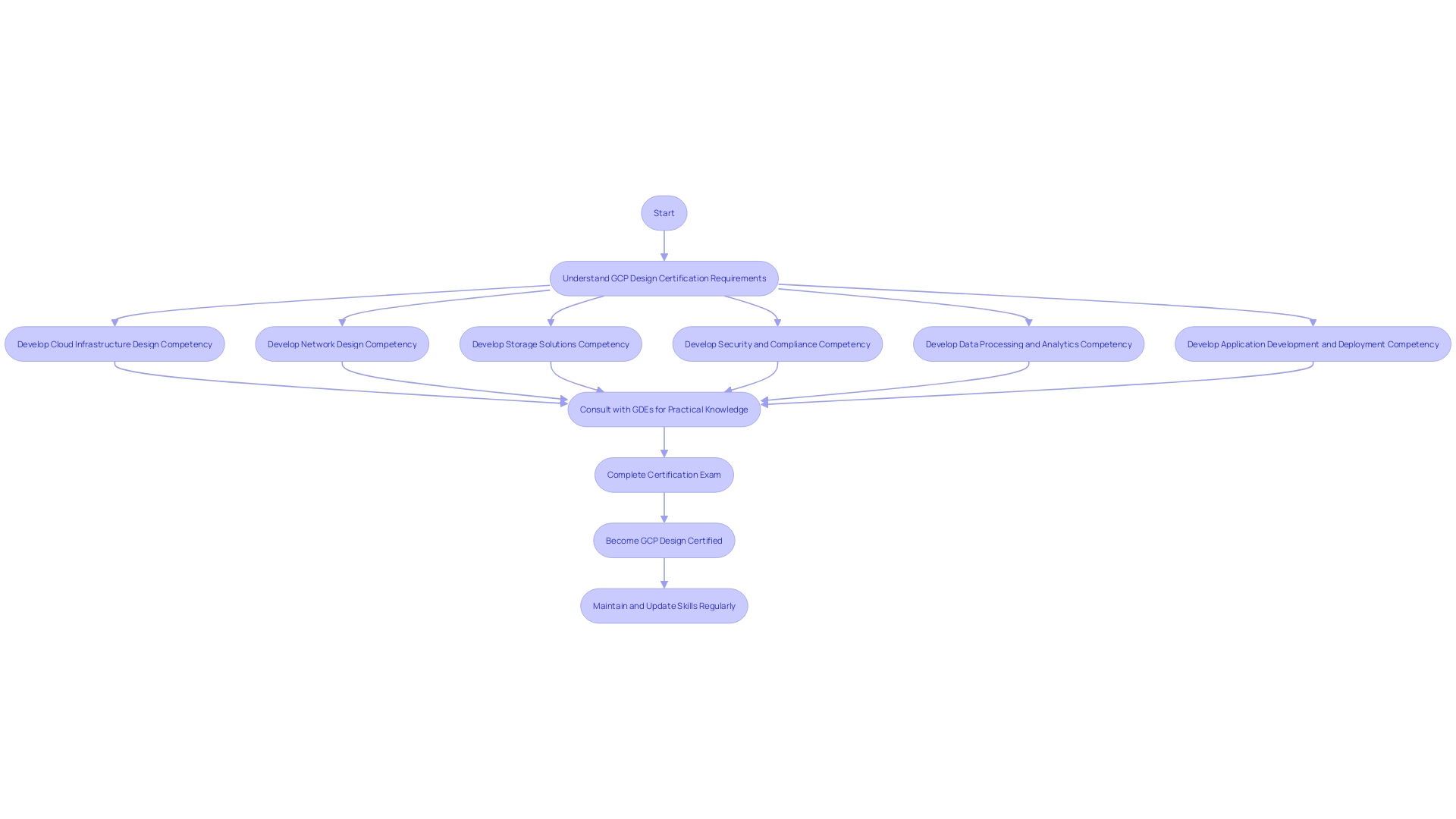
Designing and Planning a Cloud Solution Architecture
The Google Cloud Platform (GCP) certification exam is a complex assessment of one's expertise in crafting solutions for the cloud. It requires a strong understanding of how to translate business and technical requirements into a scalable and resilient cloud structure using GCP services. This encompasses the ability to integrate various aspects of technology, such as functional, integration, and information views, to create a cohesive system that aligns with the desired business capabilities.
For instance, envisioning the structure as a blueprint for delivering a service, similar to how a functional diagram illustrates the pathways for delivering a dessert, is crucial. This blueprint must account for the technological mechanisms, like ESB or REST, that facilitate the seamless connectivity of processes and channels, akin to the integration view. Furthermore, it must address the data's structure and governance models, as highlighted in the information view, to ensure efficient service delivery.
A real-world application of such architectural principles can be observed at Chess.com, where Head of Infrastructure James Kelty has constructed a stable IT infrastructure that supports over ten million daily chess games. The design is created to cater to the company's global audience, reflecting an approach that is both resilient and scalable.
In line with these practices, the design of reliable and secure GCP architectures requires familiarity with GCP's global infrastructure and an adherence to best practices. The goal is to craft solutions that are not only technically sound but also strategically positioned to drive business growth and innovation, much like the expansion strategies employed for services via various channels like WhatsApp, Web, and Telephony.
The extensive portfolio of GCP, renowned for innovation and security, provides the tools necessary for businesses to construct their own infrastructures, ranging from AI and machine learning to networking and developer tools. As computing technology continues to advance, comprehending the distinctions between public, private, and hybrid computing environments, as well as service models like IaaS, PaaS, SaaS, and serverless computing, becomes crucial.
By adopting a holistic view of software delivery and leveraging platform engineering, as suggested by EMEA Practice Solutions Lead at Google, organizations can avoid fragmented systems and achieve greater efficiency. The support of a Cloud Center of Excellence (CCoE), which combines people, technology, and processes, further underscores the importance of a multidisciplinary approach to technology adoption.
As the computing market is projected to grow at a CAGR of more than 18%, understanding the nuances of GCP's pricing structures, including list and contracted/custom prices, is also essential for effective management. This knowledge ensures that technology investments are strategically managed to maximize profitability and customer satisfaction, as emphasized by industry analysts such as Canalys.
Managing and Provisioning a Solution Infrastructure
GCP Consulting Services, with their certifications and architecture solutions, offer a robust framework for effective management of cloud computing. These services are essential for organizations like Chess.com, which hosts over ten million chess games daily and has a burgeoning user base of over 150 million. With a mission to serve chess enthusiasts globally, Chess.com relies on a scalable IT infrastructure that integrates public cloud and on-premises solutions, underpinned by services such as RackConnect Global. This infrastructure is crucial to deliver a seamless experience across different regions, exemplified by Chess.com's ability to scale Cloud Platform utilization efficiently.
Similarly, Citadel Securities, executing trades worth over $400 billion a day, leverages the cloud service provided by a major technology company to enhance its quantitative research platform. This partnership aims to improve research productivity and the price-performance ratio, highlighting GCP's capacity to handle substantial computational demands and data analysis.
Moreover, GCP is recognized for its comprehensive portfolio that caters to a wide array of computing services, from AI and machine learning to analytics and networking. Its global accessibility ensures that businesses can deploy and manage their digital infrastructure with ease. The distinction between Google Cloud and GCP is subtle, but significant; while Google's range of cloud services encompasses all of Google's cloud offerings, GCP specifically refers to the suite of cloud computing services that enable the creation of custom digital infrastructures.
For a successful GCP implementation, a Center of Excellence (CoE) is pivotal, resting on three pillars: people, technology, and processes. This multidisciplinary team fosters a culture of innovation aligned with business goals, ensuring the delivery of maximum efficiency and accelerated outcomes. The 'people' pillar is particularly critical, as it embodies the professionals carrying out the day-to-day operations and driving value for the business.
Understanding the intricacies of pricing models in the sky is also crucial. Prices, often applied to a Stock Keeping Unit (SKU), can be list prices or contracted/custom prices, which include any negotiated discounts. Understanding how pricing models develop and affect expenses is crucial for optimizing spend.
In essence, GCP consulting services and their certifications are indispensable for managing and provisioning solution infrastructure on GCP, ensuring the effective use of management tools and services for reliable operations.
Designing for Security and Compliance
Comprehending the security and compliance capabilities of Google Cloud Platform (GCP) is vital for designing robust architecture. Mastery in GCP's security services, identity and access management (IAM), data protection, and regulatory compliance ensures the integrity and security of cloud-based solutions. Sanitas, a Swiss healthcare insurer, utilized GCP to improve developer efficiency, enabling them to concentrate more on application development rather than infrastructure management, ensuring the security of their customer data during their migration. Similarly, Chess.com utilized GCP's secure infrastructure to support its massive daily user base, underlining the importance of dependable online services in scaling operations securely. With generative Ai's rise, Cloud emphasizes a secure-by-design approach, integrating privacy and security principles into its products. Eyal Estrin's insights highlight the criticality of IAM in developing applications, suggesting synchronization with an identity provider for internal users or utilizing SAML, OAuth, or OpenID Connect for external users. The GDPR and other regulations necessitate stringent adherence to data residency, minimization, and access rights, which GCP's security features are designed to address. As the landscape evolves, adopting a comprehensive security framework as recommended by Google Cloud's CISO Security Advisor is essential for maintaining a resilient security posture. This method is supported by statistics showing that leading Service Providers (CSPs) offer excellent levels of security, which is crucial for organizations to take into account when managing their security state.
Analyzing and Optimizing Technical and Business Processes
Becoming proficient in GCP's suite of monitoring and optimization tools is essential for improving management efficiency in the environment. This requires a comprehensive approach that includes dissecting workload performance, pinpointing inefficiencies, and recommending robust, cost-conscious enhancements. A deep dive into the system’s behavior is necessary to understand its inner workings and limitations. This process, as highlighted by industry experts, reveals critical system properties, empowering developers to build more intuitive and higher-performing systems in the future.
For example, companies like Chess.com, with its extensive user base of over 150 million, depend on a stable infrastructure to provide smooth experiences to chess enthusiasts worldwide. The company's Head of Infrastructure, James Kelty, emphasizes the importance of a robust digital platform to connect players across the world— a testament to the critical role of performance optimization.
Similarly, Delivery Hero's resolve to streamline account recovery processes reflects the need for efficient IT service management, which ultimately enhances employee productivity and satisfaction. These examples underscore the importance of continuous system evaluation and refinement in maintaining high performance over a product’s lifespan.
As we contemplate the growing computing market in the sky, which is expected to grow at a compound annual growth rate of over 18% by 2023, reaching a valuation of $723.4 billion, the significance of strategic sky optimization becomes even more evident. Companies must stay up to date with the latest trends, such as the integration of IoT, AI, and microservices design, to ensure their strategies in the cloud are both effective and competitive.
Performance evaluation is not merely an industry requirement; it is a strategic tool that, when executed proficiently, leads to better systems and more informed technological investments. It is by means of this perspective that one should approach analyzing workload performance and designing GCP solutions for effective management in the realm of cloud computing.

Managing Implementations of Cloud Architecture
Supervising the implementation of resilient architectures is a complex undertaking, necessitating a thorough comprehension of both the strategic and operational aspects involved. It is not merely about managing compute instances or configuring networking components; it's about orchestrating an entire ecosystem that can adapt to the evolving needs of businesses and their users. For instance, a platform like Chess.com, which hosts over ten million chess games daily and caters to a community of more than 150 million users, relies on a stable IT infrastructure. As James Kelty, Head of Infrastructure at Chess.com, emphasizes, the goal is to nurture the game's growth and the connections it fosters globally. This necessitates a profound focus on both public cloud solutions and on-premises integrations, ensuring seamless, scalable, and reliable performance across the board.
When considering solutions like Google Cloud Platform (GCP), which is recognized for its extensive portfolio including AI, ML, compute, storage, and analytics, understanding pricing models becomes critical. The distinction between list prices and contracted/custom prices is crucial, as these directly impact the cost of consumption and the overall ROI of initiatives. Moreover, adopting a multicloud strategy can offer unparalleled flexibility, allowing organizations to select the best computing environments for specific workloads, akin to choosing different modes of transportation for various destinations.
It's also important to recognize the value of a Cloud Center of Excellence (CCoE), which is anchored by the triad of people, technology, and processes. This multidisciplinary team is pivotal in nurturing a culture of innovation and aligning technology adoption with business objectives. Canalys, a worldwide expert in technology channels research, emphasizes the importance of responsiveness and adaptability in today's dynamic technology landscape, principles that are essential to effective management of remote computing resources.
In managing GCP implementations, one must exhibit proficiency in leveraging GCP's deployment and management tools, alongside the ability to troubleshoot and resolve complex issues. This involves not just a theoretical grasp of deployment strategies, but also a practical, hands-on approach that is attuned to the unique challenges and opportunities presented by the cloud computing environment.
Ensuring Solution and Operations Reliability
Ensuring strong dependability within the structure of cloud is crucial to business operations and client contentment. To achieve this, it is essential to design for fault tolerance and disaster recovery, execute effective backup and restore strategies, and adeptly manage service-level agreements.
One must consider the inevitability of failures in cloud-based systems. As illustrated by Amazon ECS, expecting the unexpected and designing for resilience are foundational principles. Amazon ECS facilitates high availability through constructs used by AWS, enabling focus on unique application features. Similarly, GCP provides features and services that support designing architectures with high availability and reliability in mind.
Deutsche Bank's migration to Google Cloud, transitioning 19 million Postbank product contracts and 12 million customer data sets into one IT platform, underscores the significance of a reliable infrastructure. This intricate consolidation showcases the need for solutions that can handle large-scale migrations while maintaining operational integrity.
Statistics show that even with a 99.99% availability rate, significant numbers of servers may fail at any given time. Therefore, it's crucial to establish availability targets that reflect business needs and to remain prepared to leverage new cloud services and features that enhance workload reliability.
During a Cloud incident affecting UniSuper, the prompt public acknowledgment and detailed post-incident review illustrate the standards of transparency and remediation expected by customers. The incident also highlighted the proactive steps taken by Google Cloud to prevent future occurrences.
When discussing reliability, the importance of the Center of Excellence (CoE), supported by the pillars of people, technology, and processes, cannot be overstated. The Center of Excellence ensures a platform that focuses on the vital aspects of cloud technology, encompassing security, compliance, and cost management.
Mark Russinovich, CTO of Azure, stresses the importance of customer engagement and support in the aftermath of incidents, highlighting the necessity of a collaborative approach between customers and providers. Clearly defined service-level objectives (SLOs) and contractual agreements between service providers and customers are fundamental to this process.
In summary, a dependable GCP cloud framework is not only about implementing solutions but also about consistently assessing, appraising, and enhancing the dependability and accessibility of these solutions to meet and surpass the anticipated uptime benchmarks.
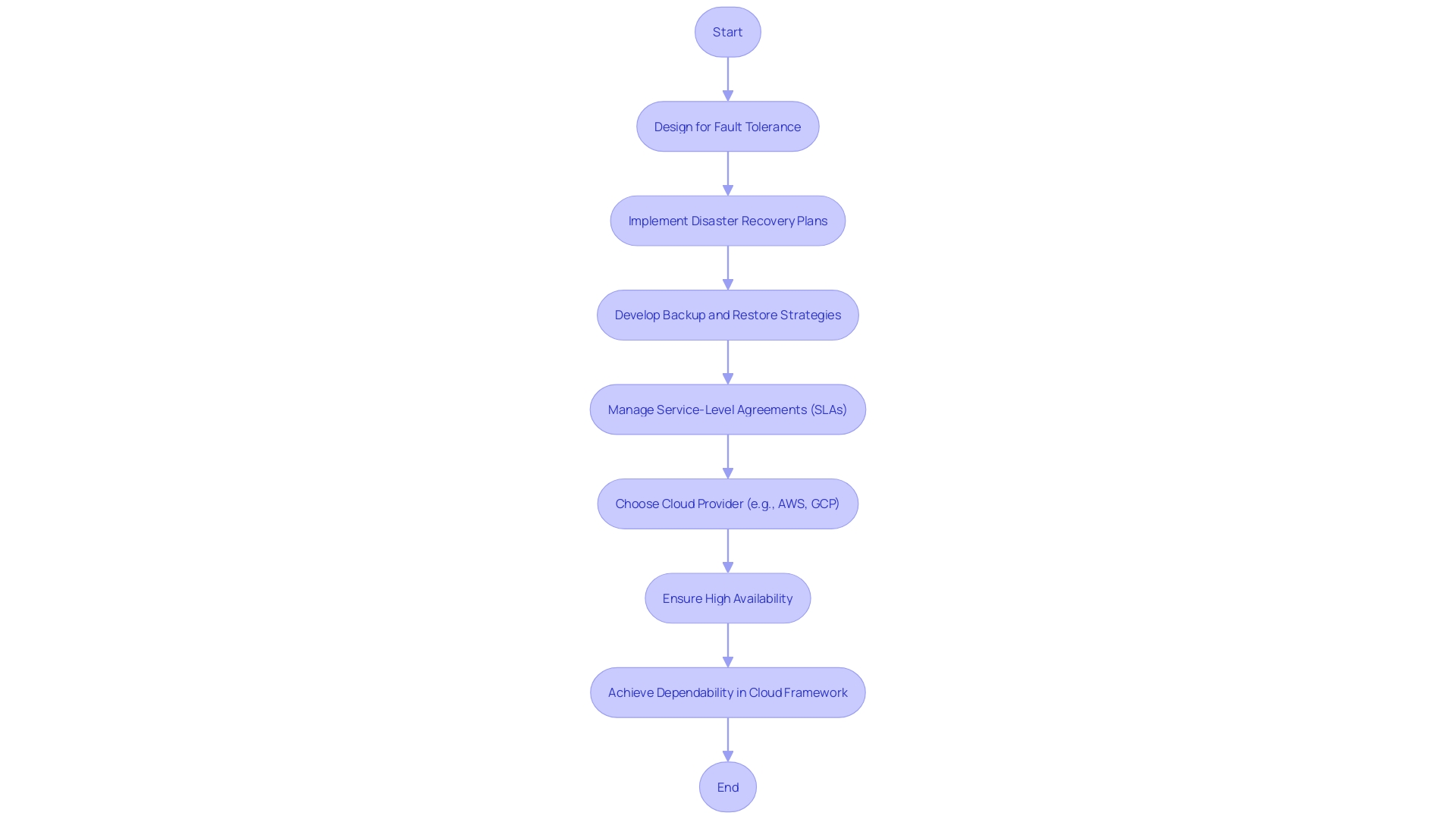
Preparation Strategies and Resources
Achieving GCP Architecture Certification necessitates a comprehensive and methodical approach. To assist you in this endeavor, employing a combination of strategic preparation tactics is recommended. Initiating with a well-structured study plan is paramount, ensuring that every aspect of the GCP services and solutions is comprehensively covered. Official GCP documentation and training materials serve as vital resources, offering comprehensive knowledge and understanding of cloud design principles.
Engaging with practical components is equally essential. Practicing with sample questions and mock exams not only fortifies your test-taking strategies but also familiarizes you with the exam format and question styles. Furthermore, the Cloud Center of Excellence (CCoE) framework emphasizes the importance of community and collaborative learning. Leveraging online communities and forums can offer additional insights and peer support which can be instrumental in navigating complex topics and sharing strategic approaches to common challenges faced during certification preparation.
Time management cannot be overstated; allocating sufficient time to study each domain of the certification ensures a thorough understanding and readiness for the exam. As Certifications from the search engine giant enhance one's market competitiveness, it is crucial to effectively utilize the available preparation resources. By following these strategies, you are not just preparing for an exam but also aligning with the industry's best practices and contributing to the advancement of your organization's technological infrastructure.
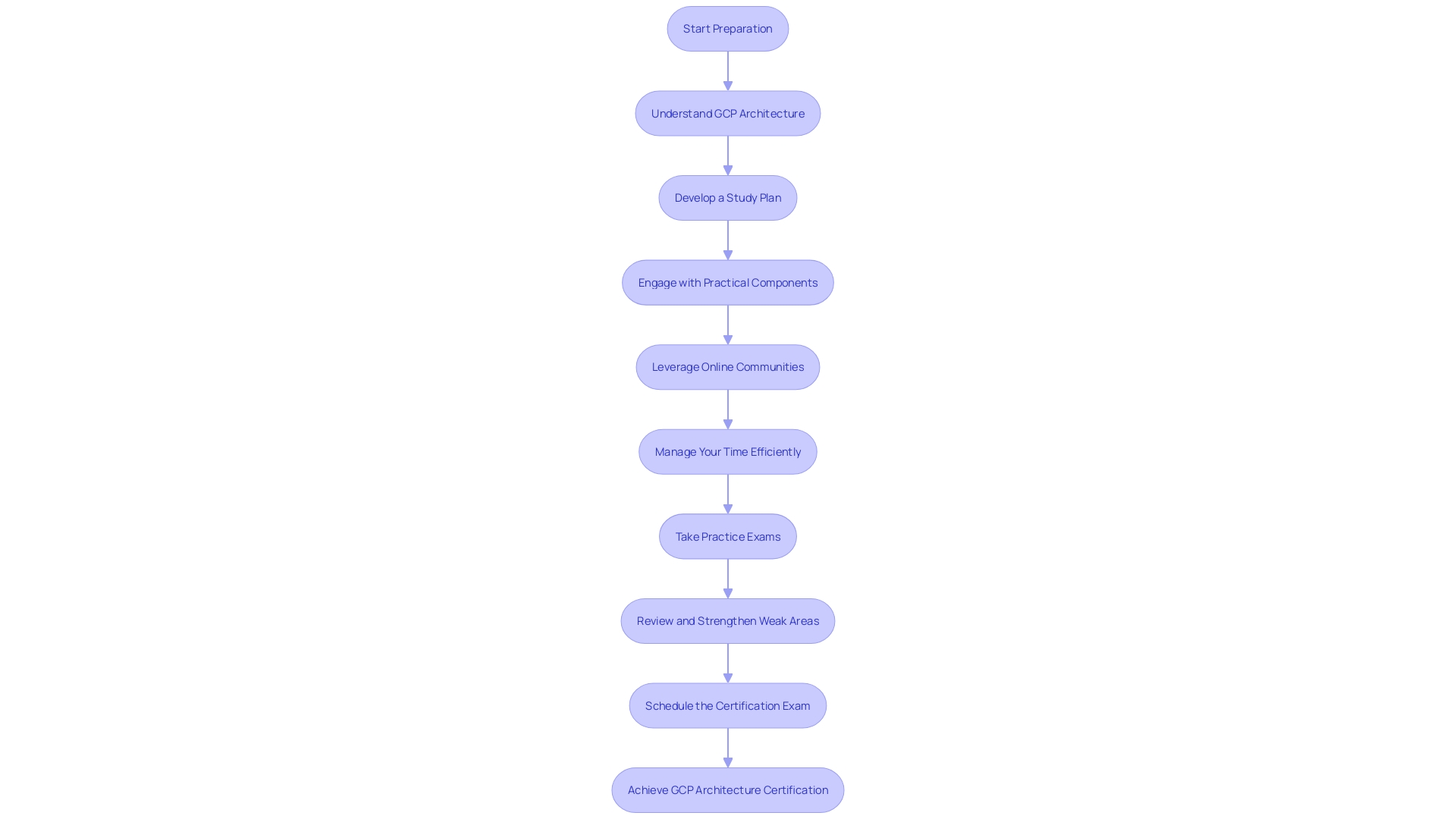
Case Studies and Real-World Applications
Examining real-life examples is an invaluable approach for comprehending the practical uses of the Cloud Platform provided by Google (GCP). Let's consider the scenario of an e-commerce business planning to launch a customer portal in Africa. Their goals entail designing an architecture with minimal latency, secure and fast access to relational user information, and storage for product images. Despite budget constraints, they require high availability, fault tolerance, and stringent security for data at rest and in transit, coupled with robust monitoring and logging systems.
Another real-world example is Nexuzhealth, a Belgian healthcare IT company striving to improve medical record management. Their preparatory stress test revealed performance anomalies, prompting collaborative diagnostics with cloud computing experts. The quick identification and resolution of the issue exemplify the platform's capacity for serverless deployments.
Similarly, Sanitas, a Swiss healthcare insurer, transitioned from on-premises servers to GCP to accelerate innovation and enhance the developer experience. This action represents a strategic change towards the sky, highlighting developer efficiency and principles that prioritize the sky.
Refreshing case studies like these, along with the latest industry news, such as Deutsche Bank's migration to an online banking platform on Google Cloud, exemplify the transformative power of GCP in diverse sectors. The Japanese real estate industry's collaboration with Visual Research to digitize and standardize processes further illustrates this point.
The adoption of multicloud strategies, leveraging the unique strengths of multiple cloud providers, is becoming increasingly prevalent. Multicloud environments offer benefits like the best feature sets for specific workloads, avoidance of vendor lock-in, and cost efficiencies. The deployment of multicloud solutions built atop open-source technologies like Kubernetes reflects a growing trend towards agile, portable, and cloud-native application development.
As we delve into these narratives and statistics, we gain a multifaceted perspective of GCP's architecture solutions in action. Each case study serves as a testament to the robustness, adaptability, and strategic value GCP offers to businesses across the globe, catering to their unique technological requirements.
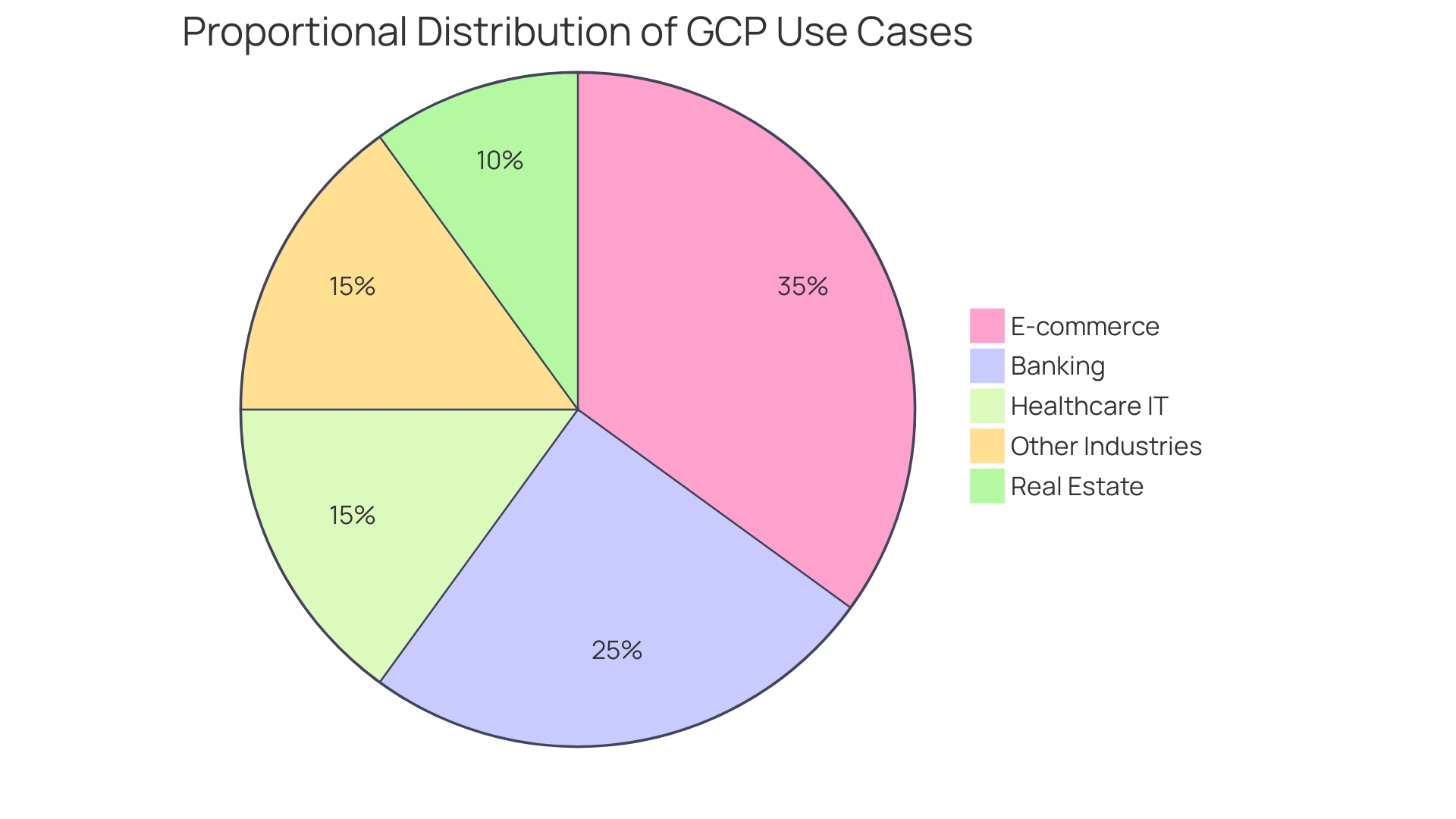
Tips for Passing the Professional Cloud Architect Exam
Obtaining the GCP Architecture Certification depends not only on a thorough comprehension of Cloud technologies but also on a strategic approach to the examination itself. To excel, candidates must adeptly manage their time, dissect questions with precision, simulate the exam environment, and implement a robust review process. These methods, when applied diligently, can significantly bolster the likelihood of acquiring the prestigious certification.
The Google Developer Experts (GDE) program exemplifies the importance of continuous learning and practical experience. GDEs, who hail from diverse backgrounds, often share their insights, highlighting the necessity of hands-on practice over theoretical study. Such active engagement with the technology is key to mastering the GCP environment. As one expert revealed, the path to expertise is built through practical projects and real-world application, rather than solely aiming for certification.
In the swiftly changing field of computing in the sky, where rates of acceptance are skyrocketing, comprehending the different models of the sky—public, private, and hybrid—is essential. The GCP portfolio offers a broad range of services, from AI and machine learning to networking and developer tools, accessible globally via the internet. It's important for architects working with virtual technology to be familiar with the various deployment and service models to fulfill specific business requirements and results.
The real-world case of Vishakha Sadhwani, whose internship in migrations led to a successful career in DevOps, underscores the transformative impact of practical experience. Her journey from hardware aspirations to expertise in cloud computing showcases the dynamic nature of careers in cloud technology and the pivotal role of hands-on learning.
Thus, for professionals aspiring to the GCP Architecture Certification, the journey involves not just understanding the foundational concepts but also engaging in practical application, learning from the community, and adapting to the ever-changing landscape of cloud-based technology.
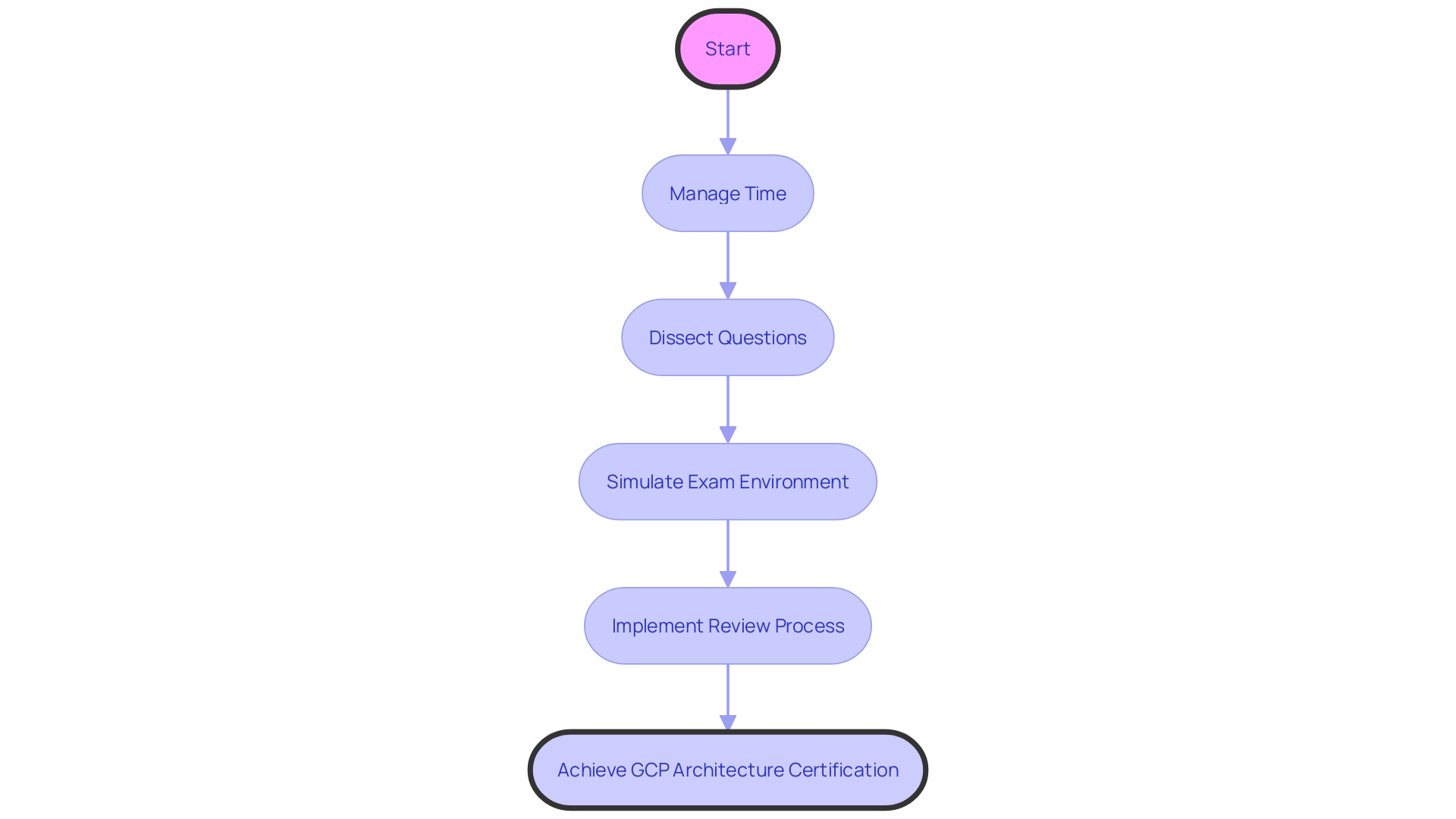
Certification Renewal and Recertification
Reaching a GCP Architecture Certification signifies a major achievement in a professional's journey in the cloud, but sustaining its significance necessitates continuous education and a proactive approach to adjusting to new developments. The landscape of cloud computing is constantly evolving, with the introduction of new features, services, and best practices that can enhance the management and operational efficiency of real estate platforms, healthcare systems, and financial services, like those implemented by Visual Research, Sanitas, and the Commonwealth Bank of Australia, respectively.
Recertification is more than a periodic milestone; it's a commitment to continuous improvement and staying ahead of the curve. The efforts of Visual Research to standardize real estate processes and the migration of Sanitas to the cloud, aiming to enhance developer efficiency, demonstrate the tangible benefits of embracing cloud innovations. Similarly, the Commonwealth Bank of Australia's introduction of interest-free finance for sustainable energy solutions is an example of leveraging financial technology to facilitate consumer access to solar and battery systems.
As technology evolves, professionals must update their skills to manage these advancements effectively. A Center of Excellence (CoE), supported by the integration of people, technology, and processes, serves as a strategic framework for cultivating a culture of innovation and maintaining certification relevance. The Center of Excellence for Cloud Services (CECS) specifically focuses on governance aspects like security, compliance, and cost management, which are crucial for cloud infrastructure.
Embracing continuous learning and staying attuned to the latest technologies and regulations is not just beneficial—it's essential. As pointed out by industry experts, being deliberate and realistic with technology investments ensures sustained impact and relevance. With a multitude of resources available, certified professionals can remain at the forefront of cloud architecture solutions through structured learning paths, community forums, and hands-on projects that reflect current industry demands and trends, as underscored by NCARB's Analysis of Practice study.
In essence, the recertification process is an opportunity to align one's skills with the needs of an ever-changing technological landscape, ensuring that the value of the GCP Architecture Certification continues to resonate within the industry and contribute to the success of one's career.
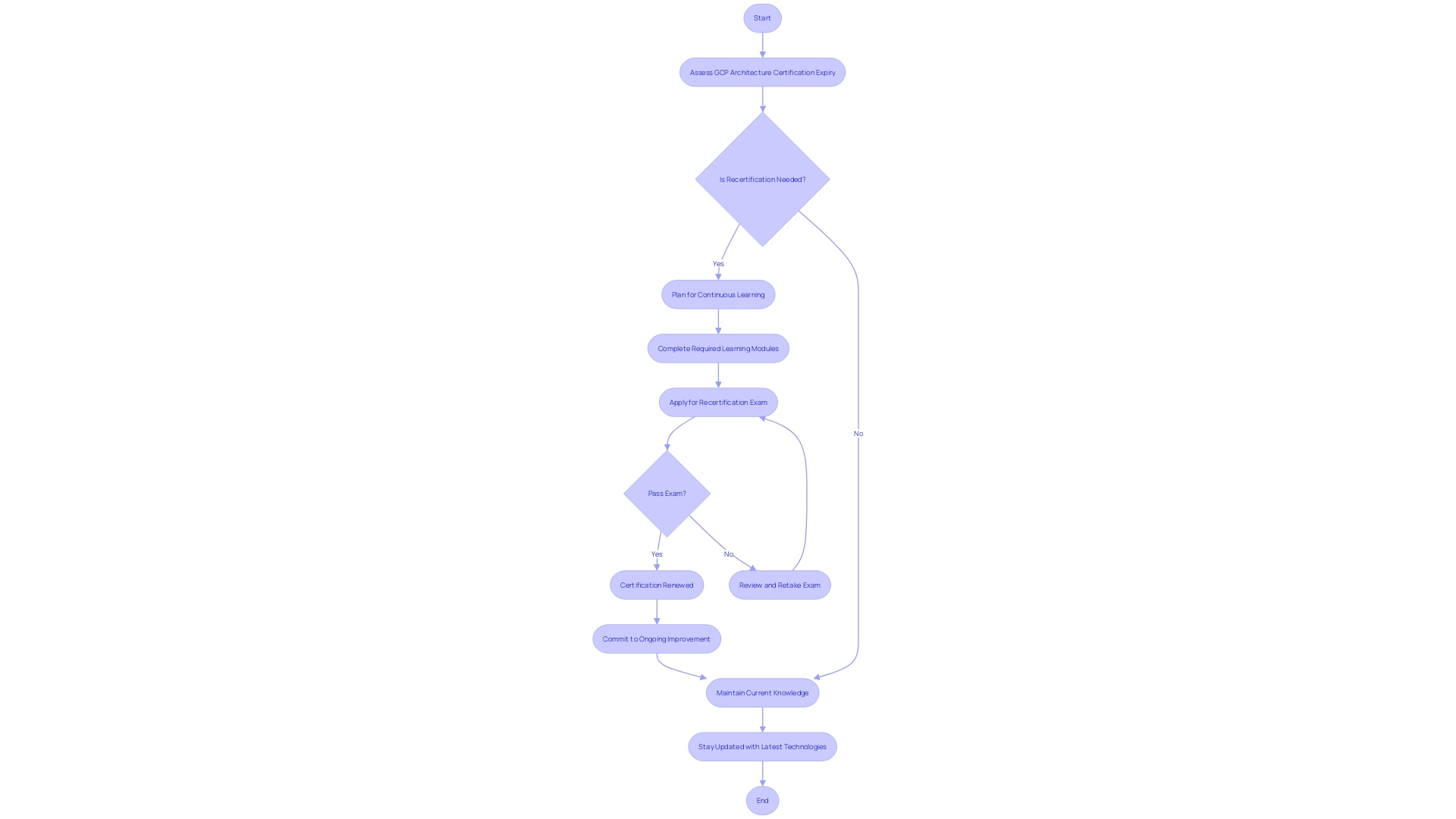
Conclusion
In conclusion, the Google Cloud Platform (GCP) Architecture Certification is a significant achievement that certifies professionals' proficiency in crafting and managing cloud solutions within the GCP ecosystem. It serves as a hallmark of expertise, validating skills and bolstering professional stature.
The case studies showcased the critical role that certified cloud architects play in innovating and refining technology-driven business solutions. The Center of Excellence (CoE), particularly the Cloud Center of Excellence (CCoE), emphasizes the 'people' pillar alongside technology and processes, providing a framework for effective cloud strategies.
The GCP Architecture Certification guide equips individuals with the knowledge and skills to drive effective cloud management and innovation within their organizations. By achieving this certification, professionals gain a competitive edge in the job market and contribute to the advancement of their organizations' technological infrastructure.
Ongoing education and a proactive approach to adapting to new developments are crucial for maintaining certification relevance and staying at the forefront of the industry. By staying updated with the latest developments, professionals can continue to demonstrate their expertise and contribute to the success of their careers.
In summary, the GCP Architecture Certification is a testament to professionals' adeptness in cloud architecture. It validates skills, enhances professional stature, and equips individuals to effectively manage and innovate in the cloud. By embracing continuous learning and staying abreast of industry trends, certified professionals can maintain their competitive edge and contribute to the success of their organizations.




